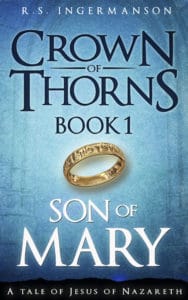They didn’t celebrate Mother’s Day in first-century Nazareth.
But pretend for a moment that they did. How many Mother’s Day cards would Mary have gotten?
That’s not an easy question to answer, because we don’t know how many children Mary had.
There’s an old tradition that Mary was a lifelong virgin and only ever had one child, Jesus.
But not everybody accepts the idea that Mary was a perpetual virgin. This is a church tradition that doesn’t go back to the first century. What does the Bible tell us?
What Mark Tells Us
The gospel of Mark mentions several siblings of Jesus. In Mark 6:3, we see the names of four brothers, James, Joses, Judas, and Simon.
These are English transliterations of traditional Hebrew names, Yaakov, Yosi, Yehuda, and Shimon.
Yosi is a nickname, a short form for Yoseph. In a home where the father is already named Yoseph, it makes good sense to give a son with the same name a nickname.
Mark 6:3 also mentions an unspecified number of sisters (plural). This means there must be at least two sisters, but it’s also plausible that he had three, or even more. My own guess is three, because that balances better with the five sons in the house. But it’s just a guess.
What Matthew Tells Us
The gospel of Matthew doesn’t add much to Mark’s information. The author of Matthew had a copy of Mark when he wrote his gospel, and he often follows it pretty closely. In Matthew 13:55-56, the four brothers are listed, but with a slight variation in the names and the order. Here, they’re called James, Joseph, Simon, and Judas.
So Matthew calls the second brother Joseph, not Joses. And he swaps the order of the third and fourth brothers.
This tells us that Matthew knew the full name of Yosi to be Yoseph, which is not at all surprising.
Also, it seems plausible that Matthew knew the correct order of sons and wanted to set the record straight. Neither Mark nor Matthew actually says that they are giving the actual birth order, but generally brothers in a family are listed in their birth order, or close to it.
My own guess is that Shimon was older than Yehuda, but that they were close in age, and Yehuda may have been physically bigger.
Matthew again leaves the sisters of Jesus anonymous, just as Mark did. And I can’t think of any other mention of sisters of Jesus anywhere else in the New Testament. The reason for this is simple. It was a patriarchal society. When sisters got married, they married out of the family.
What Luke Tells Us
The gospel of Luke only mentions the siblings of Jesus once. In Luke 8:19-21, we read that Jesus’s mother and his brothers came looking for him, but couldn’t get into the house because it was so packed. They got upset when Jesus said that all the people listening were his mother and brothers.
Similar episodes show up in Matthew 12:46-50 and Mark 3:31-35.
So Luke gives us no new information.
What John Tells Us
The gospel of John mentions the brothers of Jesus on several occasions.
In John 2:12, immediately after the story of Jesus changing water to wine, we read that Jesus and his mother and his brothers went to Capernaum and stayed there for some days. This gives us no new information, other than that the whole family was going around the countryside together at some point. But that changed…
In John 7:1-10, there’s a short story telling about how Jesus’s brothers urged him to go the Feast of Tabernacles in the fall of some year, pointing out that if he wanted to get famous, that would be the place to do it. Jesus declined to go, but his brothers went. And the text says rather pointedly that his brothers were not his followers. However, it seems there was some sort of reconciliation…
John 20:17 tells the famous story of an appearance by Jesus to Mary Magdalene on the very first Easter Sunday. Jesus gave her a message for his brothers. (A similar incident is recounted in Matthew 28:10.)
Three Theories on the Siblings of Jesus
All of this leads us to the crucial question, how exactly were these “brothers and sisters” related to Jesus?
There have been three main theories put forth over the years:
- These “brothers and sisters” were children of both Joseph and Mary.
- They were children of Joseph by a previous wife; Mary was a perpetual virgin.
- They were cousins of Jesus, the children of Joseph’s brother Alphaeus; both Mary and Joseph were perpetual virgins.
You can believe whichever of these you like. My own thinking is that #1 seems most plausible in view of the data we have. #2 and #3 seem to me to be driven by theological reasoning.
So How Many Mother’s Day Cards for Mary?
Now we can return to the original question. How many Mother’s Day cards would have been due to Mary?
If you go with theories #2 or #3, then your answer is that Mary only got one card.
If you agree with me that #1 seems like the most reasonable theory, then it seems that Mary would have been due at least 7 cards, and maybe 8. (Jesus plus four brothers plus two or three sisters.)
But there’s another consideration. The infant mortality rate in antiquity was shockingly high.
Roughly half of all children died before the age of puberty. And half of those died in the first year of life. If Mary had 7 or 8 children who lived to adulthood, then she could very plausibly have borne around 15 children. Of those, 3 or 4 would have died in infancy, and another 3 or 4 would have died as children, but lived at least long enough to know their mother.
So it’s very reasonable that Mary might have been eligible to receive Mother’s Day cards from as many as 11 or 12 different children (although they might not have all been alive at the same time).
Of course, nobody gave Mother’s Day cards in the first century. But certainly it was a commandment to honor your mother, and Jesus no doubt did.


Loved this! It’s astonishing how many times one can read a Gospel and still overlook key information like this. I knew for certain Jesus had a brother named James (Yakov). Knew about Jude, because he also had his own book like James. Didn’t know about the other two. When I first read “Son of Mary” (a fantastic book, btw, highly recommended) I thought the other two brothers and the sisters were speculations on the author’s part. Didn’t bother to look it up.
One thing “Son of Mary” taught me was just how much I accepted as fact what was really theological tradition that came much later. An eye-opening experience. Thanks for this blog!
Thanks for your comments, Mel!
I remember back in grade school, our fourth-grade class got into this huge argument over how many kings came to visit the baby Jesus in Bethlehem.
The ENTIRE class insisted that there were three kings.
ONE girl alone said that the Bible didn’t actually say how many kings there were. She said we can’t know how many kings there were.
I couldn’t remember, so I didn’t join in the argument. But I went home and checked, and that girl was right. The Bible doesn’t say. The kings are only mentioned in the gospel of Matthew, and there is no number given there.
The lesson I took from that, which has stayed with me since forever, is that it’s easy to think you know something when you’re merely accepting tradition. (In that case, the tradition of the song We Three Kings.)
And another lesson I have learned since then is that information is often distributed across several sources, and if you don’t compare them closely, you may miss things. But if you do compare all the sources side by side, you may be able to put 2 and 2 together and learn something new that would not have been possible to deduce from any single source alone.
Thanks for your kind words on “Son of Mary,” Mel. That book is a prime example of years of side-by-side comparisons, looking at every possible source I could find to put lots of things together that I had never thought of before.
[…] his mother and father and brothers and sisters. For more on the family of Jesus, see my blog post Mother’s Day With Jesus. […]
[…] discussed all this in a previous blog post, Mother’s Day With Jesus, so I won’t go over that ground […]